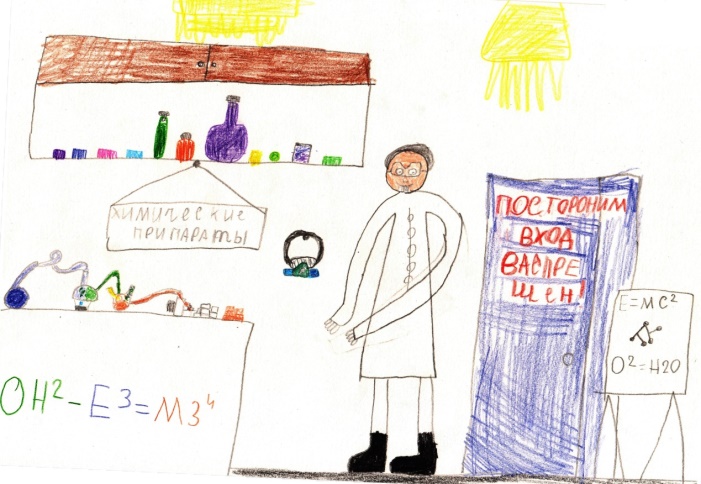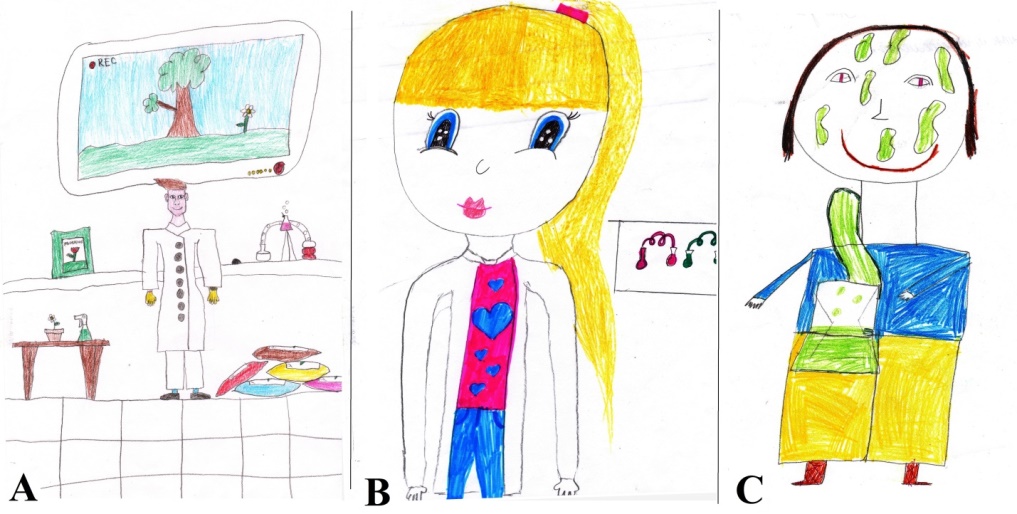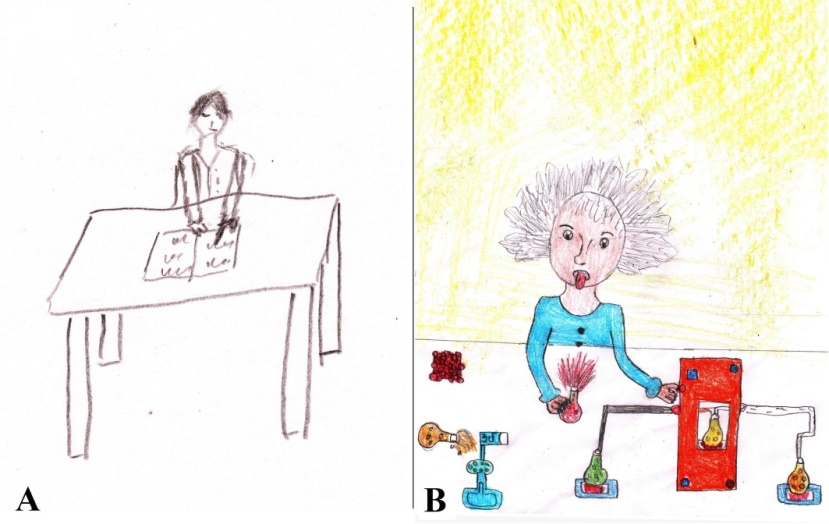Opportunities And Specificity Of Applying The Draw-A-Scientist Test Technique On Russian Schoolchildren
Abstract
The present article discusses the results of the first-ever Draw-a-Scientist Test (DAST) used in Russia to study the image of a scientist which children develop at the age of 9-11 years old. The patterns revealed in their perception of a scientist are compared with those obtained by means of DAST in other countries on a similar sample. They have found the image of a scientist to remain stable regardless of the cultural context. Younger schoolchildren are characterized by structuring the image of a scientific worker on the basis of such stereotyped criteria or indicators, attributing a person to the scientific community, as: clothing, eyeglasses, facial hair growth, symbols of research and knowledge, scientific results and relevant captions. In addition to these, junior schoolchildren’s social and perceptive imagery includes gender, race, age, object environment, elements of danger and facial expressions. The following stereotypic indicators of the image of a scientist are found to be specific to the domestic sample: a scientist has his hair standing on end, a bald patch on his head, a disproportionately large head, dirty clothes, and is young. There are general trends, such as: uncertainty of the image and its archaization. The results obtained show that children possess incomplete information about the activity of scientists and have an undeveloped and amorphous perception of this image.
Keywords: StereotypescientistDASTa picture testindicator or criteriaimage
Introduction
The choice of career and subsequent professional socialization and self-realization are the most important stages in an individual’s life path. Apart from one’s individual personal inclinations, interests, abilities, preferences, value orientations and opinions of the immediate social environment (parents, relatives and peers), the factors of professional choice also include the child's representations about existing professions, their realities and a detailed character (Klimov, 2004). A significant role in professional self-determination belongs to public opinion, society’s perception of this or that profession, and the degree of recognition and respect by representatives of the profession which the subject wants to pursue. All of these apply justly to the profession of a scientist.
The development of the image of science and that of a scientist in children largely occurs indirectly without their communication with a scientist in person. The key to this process is held by mass media whose content and emotional-evaluative level have a great effect on the formation of ideas in younger generation about science and scientists and form stereotypes of their perception of a scientist. For example, the leitmotif of the cinematographic image of a domestic scientist during the Soviet period includes his self-sacrifice, rejection of narrow-minded interests and his service to the cause and people, each of which is interpreted as a criterion of scientific truth (Medvedeva, 2015; Zudina, 2011). The images of scientists being translated by modern media tend to be less unambiguous and more multifaceted that makes it difficult to form appropriate conceptions in children. At the same time, the less stereotypical the image of scientists among schoolchildren and students are, the more likely they are to positively relate to science and, subsequently, choose scientific activity as a professional career (Bodzin &Gehringer, 2001; Christidou, 2011; Matkins, 1996; Rosenthal, 1993). The content characteristics of the standard image of a scientist are studied and summarized on a sample of more than 4,000 respondents by using Chambers’s Draw-a-Scientist Test (DAST) as the main methodological instrument (Chambers, 1983). The results allows the author to identify seven indicators, the presence of which in the drawing corresponds to the stereotypic image of a scientist, viz: a lab coat, eyeglasses, facial growth hair (moustaches, beards, etc.), symbols of research (instruments and laboratory equipment), symbols of knowledge (books and filing cabinets), technology (the products of science), relevant captions (formulae, comments like “Eureka!” and “I’ve discovered”, etc.). These stereotypes of a person belonging to the scientific community are of stable and cross-cultural nature and develop by the age of 9-11 years old, which has been confirmed by the samples of children in Bolivia, Greece, Colombia, the USA, Turkey and Sweden (Chabay, 2008; Christidou et al., 2012; Korkmaz , 2009; Jerez & Middleton, 2011; Miele, 2014; Monhardt, 2003; Türkmen, 2008).
Notwithstanding a rather long history of the DAST use by foreign colleagues for studying the image of a scientist, Russia has never seen it applied. It leaves a significant gap in cross-cultural studies of the image of a scientist.
Problem Statement
Scientific breakthroughs can only be accomplished by means of combining resources (including human ones) from different countries. In setting up international scientific corporations and organizing their work, it is important for their participants to share values and normative ideas about scientific work, which is bound to facilitate and streamline business interaction in this field. Having been developed in childhood, the concept of scientists and scientific activity leaves an imprint on one’s attitude to the profession in the future, on the choice and specificity of its implementation. This calls for cross-cultural studies to investigate the formation of the image of a scientist in different countries.
Research Questions
-
Does the image of a scientist among Russian children differ from that found in other countries?
-
What are the specifics of junior schoolchildren’s perception of a scientist based on the use of DAST?
-
What are the diagnostic capabilities of the DAST method after its adaptation it to use on a Russian sample?
Purpose of the Study
The pilot study of the image of a scientist in Russian children by using DAST aims to establish the presence and content of stereotyped indicators of the image of a scientist, and to compare the patterns obtained with those established earlier.
Research Methods
The Draw-a-Scientist Test was used as a main research method.
Subjects (cases)
The study was conducted in the city of Yaroslavl in 2016-2017. The sample consisted of 241 schoolchildren aged from 9 to 11 years old (the average age 10.4 years old) of primary school. There were 124 girls (51.5%) and 117 boys (48.5%) among the subjects under test.
Procedure
The course of the study, instructions and equipment were in full compliance with the classical DAST procedure developed by D.W. Chambers (1983). When analyzing the drawings, we assessed both stereotypical indicators proposed by D.W. Chambers and additional characteristics of the image of a scientist, as proposed in later works (Jerez &Middleton, 2011; Leblebicioglu, et al, 2011; Türkmen, 2008).
Findings
The results allowed for cross-cultural comparison with the data obtained on similar samples (in terms of age, education, gender, and time parameters) in Bolivia, Colombia and Turkey (see Table
The results showed that the stereotypic indicators of a scientist, singled out by D.W. Chambers (1983), occurred with as much frequency as they did in foreign samples. There were practically no drawings where all the 7 indicators were present simultaneously. Some of the indicators are much less common in Russian children than in their peers from other countries. As few as 35.68% of the children drew the scientist in a lab coat in the situation of laboratory experiments (Fig.
The eyeglasses in the Russian children’s drawings occurred with about the same frequency as that in children from other countries. They continued to be associated with research and, primarily, reading (45.64% of the images) (Figure

Facial growth of hair (moustaches, beards and sideburns) was depicted by 23.24% of the Russian children, and this corresponded to the frequency of this indicator in the drawings by children from other countries. This cast doubt on the high degree of stereotype of the indicator. With the Russian children, this indicator could be transformed or supplemented with hair standing on end (18.67% of the drawings) (Figures
The most frequent stereotypic indicator appearing in the Russian schoolchildren’s drawings is the symbols of research (most often, these were vials, beakers and retorts) - 69.29% (Figures

Symbols of knowledge (books, filing cabinets, etc.) are also found to have little presence in the drawings by the Russian children - 36.10% (the same is true for children from other countries) (figure
The qualitative content of the last two indicators makes it possible to identify that what we term to be "archaization" of the image of a scientist in the minds of children. This is a phenomenon in which their perception of his personality and the specifics of his activity has a time lag of several decades. In the children’s minds, a scientist is a man from the past who is excluded from real life. It reveals that in 18.7% of the cases the children draw the scientists they know to have existed in the past: Einstein, Mendeleev, Darwin (Figure
Technologies (the products of science) featured both material products (beakers full of liquids, robots and machines) and non-material results (ideas and insights). This indicator emerged in the drawings by the Russian children even more frequently than in those by children from abroad (49.38%). However, the fact that labour results are absent in more than half of the drawings shows that, firstly, children are little aware of connection between surrounding everyday objects and scientific discoveries and solutions; secondly, they believe scientific research to be abstract and incorporeal (Fig.

The relevant captions were presented in the form of mathematical formulae, warnings of danger, of the "Hurray" and "It's for sure" type of exclamations (34.44%); they occurred with about the same frequency as in children from other countries (Fig.
We have examined some of the alternative indicators of the image of a scientist above. As far as others are concerned, one should note that Russian children show certain differences from their foreign peers.
Senior age is one of the typical alternative criteria that the authors use for distinguishing. But according to our data, a mere 9.12% of the children depict a scientist older than 55 years old, while 45.22% of the respondents show a young scientist who is younger than 35. Thus, in the minds of Russian children, the scientist is a young man (Figures
No elements of mysticism were found to be present in the Russian children’s drawings, but 6.4% of them depicted fabulous objects. They are the time machine, aliens and anti-gravity devices. That also results from watching science fiction films that feature scientists. Nor were signs of secrecy found in the work of scientists. At the same time, 9.3% of the cases pictured some danger that involved not only the scientist (explosions, contamination and injuries - Figure
The analysis of the environment in which the children put the scientist showed that the scientists were most likely to be in the laboratory (46.47%, which were also much more rare than in the case of their foreign peers) (Figures
What we believe to be a specific feature of the Russian sample is a considerable degree of uncertainty in the drawings (figure
However, there are also some indicators, in which the rate of coincidence with foreign results is very high. Most of the drawings (99.59%) depict Caucasian scientists. There is only one case which depicts a black scientist, since the author of the drawing had seen one in the cinema.
Thus, the alternative indicators of the image of a scientist show significantly greater differences in the perception of a scientist among Russian children and their foreign peers, while a considerable part of the stereotypes observed is the result of the impact the media and film industry have on them.
Conclusion
The study has shown significant similarities between the image of a scientist in the minds of Russian children and those of other countries. There are some stereotyped indicators, such as: laboratory coats, eyeglasses, facial hair (moustaches, beards, etc.), symbols of research (instruments and equipment), and knowledge (books and filing cabinets), technology (the products of science) and relevant captions (formulae, “Eureka!”, “I’ve found!”, etc.). At the same time, frequency of occurrence of these indicators both in the drawings by the Russians and those by foreign children shows a certain loosening of stereotypes in the image of a scientist, and apparently, the formation of new ones that need to be studied.
The usage of DAST on the Russian sample enables us to establish a number of specific features of the image of a scientist in children aged 9-11. The schoolchildren demonstrate a formless, blurred, unclear and poorly detailed image of a scientist. This may be due to the fact, they are little aware of a scientist's activity and have extremely vague ideas about both the field of scientific activity and its representatives. We have also observed archaization of the image of a scientist. In the children’s minds, it is associated with scientists of the past as they attribute obsolete ways of working and tools of their profession. This is due to the lack of the respondents’ interest and emotional appeal of scientific activity field. Development of representations about scientific work and scientists in children is highly influenced by mass media. It finds its expression in translating some standard images into their drawings: young age and some relevant appearance (hair standing on end, a bald patch on the head, a disproportionately large head, soiled clothes, young age, etc.). These may be additional stereotyped indicators specific to the Russian sample. There is also some ambiguity in gender stereotype about the field of science as a purely male-dominated field of activity.
Thus, the first experience of using the Draw-A-Scientist Test on the sample of Russian schoolchildren has revealed its diagnostic value. Nevertheless, it is necessary to clarify the patterns observed and content and range of its indicators. It necessarily involves continuing efforts to study the image of a scientist and a scientific group by using the present method. This research technology can be utilized to study and build psychological programs designed to support young people in their career choice, help form public opinion about science and address staffing issues with the aim of preserving tradition and continuity in the professional scientific community.
References
- Bodzin, A., Gehringer, M. (2001). Can meeting actual scientists change students’ perceptions of scientists? Science and Children, 39(1), 36-41.
- Chabay, L. A. (2008). Myself as a researcher – an analysis of children’s images of scientists, VA Report, 3, 24. https://www.v-a.se/downloads/varapport2008_3.pdf
- Chambers, D.W. (1983). Stereotypic Images of the Scientist: The Draw-A-Scientist Test, Science Education 67(2), 255-265.
- Christidou, V. (2011). Interest, attitudes and images related to science: Combining students’ voices with the voices of school Science, teachers, and popular science, International Journal of Environmental & Science Education, 2, 141-159.
- Christidou, V, Hatzinikita, V, Samaras, G. (2012).The image of scientific researchers and their activity in Greek adolescents' drawings, Public Underst Sci.; 21(5), 626-47
- Jerez, W. M., Middleton, K. (2011). Using the DAST-C to explore Colombian and Bolivian students' images of scientists, International Journal of Science and Mathematics Education, 9: 657-690.
- Klimov, Ye. A. (2004). Psikhologiya professional'nogo samoopredeleniya [Psychology of Professional Self-Determination]. M.: Izdatel'skiy tsentr “Akademiya” [M: The Publishing Center "Akademiya"], 304. [in Russian].
- Korkmaz, H. (2009). Gender Differences in Turkish Primary Students’ Images of Astronomical Scientists, Astronomy Education Review, 8(1). http://portico.org/stable?au=pgg3ztfc6n9
- Leblebicioglu, G., Metin, D., Yardimci, E., Pinar S. C. (2011).The effect of informal and formal interaction between scientists and children at a science camp on their images of scientists, Science Education International, 3, 158-174.
- Matkins, J. J. (1996). Customizing the Draw-a-Scientist Test to analyze the effect that teachers have on their students’ perception and attitudes toward science. http://www.ed.psu.edu/CI/Journals/96pap44.htm.
- Medvedeva, S. M. (2015). Moral'nyy vybor uchenogo v izobrazhenii sovetskogo kino [Moral choice of a scientist in the depiction of Soviet cinema], ХХ Shishkinskiye chteniya: nauka i etika v sovremennom mire [XX Shishkin readings: science and ethics in the modern world] http://www.vestnik.mgimo.ru/sites/default/files/pdf/043_shishkinskie_chteniya_medvedevasm.pdf [in Russian].
- Miele, Е. (2014). Using the Draw-a-Scientist Test for Inquiry and Evaluation, Journal of, 4,36-40.
- Monhardt, R.M. (2003). The image of the scientist through the eyes of Navajo children, Journal of American Indian Education, 42(3), 25-39.
- Rosenthal, D. B. (1993) Images of scientists: A comparison of biology and liberal studies majors, School Science and Мathematics, 93, 212-216.
- Türkmen, Н. (2008). Turkish Primary Students’ Perceptions about Scientist and What Factors Affecting the Image of the Scientists, Eurasia Journal of Mathematics, Science & Technology Education, 4(1), 55-61.
- Zudina, A. A. (2011). Nauka i obraz uchenogo v sovetskom kino (1928-1986 gody) [Science and the image of a scientist in the Soviet cinema (1928-1986)], Obshchestvennyye nauki i sovremennost' [Social Sciences and Modernity], 5, 167-176. [in Russian].
Copyright information

This work is licensed under a Creative Commons Attribution-NonCommercial-NoDerivatives 4.0 International License.
About this article
Publication Date
13 July 2018
Article Doi
eBook ISBN
978-1-80296-042-6
Publisher
Future Academy
Volume
43
Print ISBN (optional)
-
Edition Number
1st Edition
Pages
1-694
Subjects
Child psychology, developmental psychology, child care, child upbringing, family psychology
Cite this article as:
Razina, T., & Volodarskaya, E. (2018). Opportunities And Specificity Of Applying The Draw-A-Scientist Test Technique On Russian Schoolchildren. In S. Sheridan, & N. Veraksa (Eds.), Early Childhood Care and Education, vol 43. European Proceedings of Social and Behavioural Sciences (pp. 109-117). Future Academy. https://doi.org/10.15405/epsbs.2018.07.16

